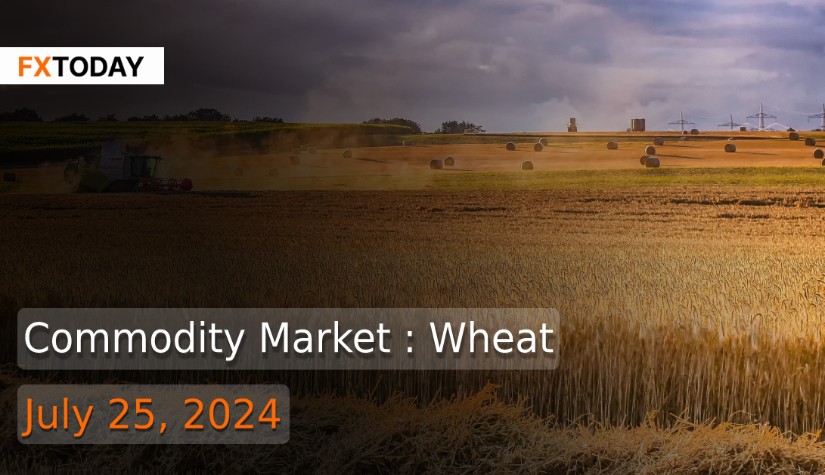Mixed Wheat Prices Amid Market Influences and Global Production Trends
The wheat market showed mixed trends with increases in Chicago and Kansas City and a decline in Minneapolis. Wheat is influenced by the late winter wheat harvest and potential stress on spring wheat in the U.S. Plains and Canada. A significant U.S. spring wheat crop tour is underway, showing early yields higher than last year. The market is also watching conditions in the Black Sea region and Europe, where rain is delaying harvest in parts of France and Germany, affecting quality. Argentina's June wheat exports were the lowest this year at 292,000 tons but still ahead of last year's pace. The European Commission reports soft wheat exports at 1.44 million tons since July 1st, compared to 2.21 million tons last year.
For the 2024/25 U.S. wheat outlook, larger supplies, domestic use, exports, and ending stocks are expected. Wheat production is forecasted to increase by 134 million bushels due to higher harvested areas and yields. Spring wheat and Durum production are expected to increase to 578 million and 89 million bushels, respectively, while winter wheat production is also expected to rise to 1,341 million bushels. Beginning stocks are up, and imports are down by 15 million bushels. Feed and residual use is increased by 10 million bushels. Exports are projected to rise by 25 million bushels to 825 million. Ending stocks are expected to increase by 98 million bushels to 856 million, the highest in five years, with a projected farm price of $5.70 per bushel.
Globally, the wheat outlook for 2024/25 anticipates larger supplies, consumption, trade, and stocks. Supplies are expected to increase by 6.9 million tons to 1,057.2 million, mainly due to higher production in the U.S., Pakistan, and Canada. Pakistan's production is forecasted to reach a record 31.4 million tons, and Canada's production is expected to increase to 35.0 million tons due to better moisture conditions. Global consumption is projected to rise by 1.9 million tons to 799.9 million. World trade remains virtually unchanged at 212.9 million tons, with higher exports from the U.S., Canada, and Pakistan being nearly offset by reductions from the EU, Turkey, and Uzbekistan. Global ending stocks are expected to increase by 5.0 million tons to 257.2 million, mainly due to increases in the U.S., China, Argentina, Pakistan, and Canada, which will more than offset reductions in Russia, the EU, and Iran.
The Australian Securities and Investment Commission (ASIC) has accused COFCO, a Beijing-owned agribusiness giant, of manipulating Australian commodities contracts over 30 times before Russia's invasion of Ukraine in 2022. ASIC has taken legal action against two COFCO subsidiaries, alleging they manipulated a January 2023 wheat futures contract in Australia by placing orders just before the ASX24 derivatives exchange closed, affecting the settlement price. The regulator claims COFCO's actions distorted genuine market supply and demand, creating artificial prices. COFCO, owned by the Chinese government, is China's largest food processor, manufacturer, and trader, with significant investments in Australia, including Tully Sugar and an interest in Swisse vitamins.
The U.S. Department of Agriculture (USDA) reports that Brazil aims to become self-sufficient in wheat within the next decade. The USDA attaché in Brasilia highlights that this goal includes cultivating "tropical wheat" in the Cerrado region, known for its resistance to dry conditions. Currently, 87% of Brazil’s wheat is produced in the southern states of Rio Grande do Sul and Paraná. The Cerrado, which covers 22% of Brazil, will see an increase in wheat cultivation, potentially expanding from 620,000 acres to 870,000 acres and producing an additional 300,000 tonnes of wheat. The plan includes converting degraded pastures to wheat fields. Brazil's wheat production is forecasted at 9.5 million tonnes for 2024-25, though Conab projects nine million tonnes. Brazil imports 12 million tonnes of wheat annually, with 80% coming from Argentina.
In Egypt, a study in the Journal of Agriculture and Food Research notes that while wheat productivity has increased due to high-yielding varieties and government support, climate fluctuations have adversely affected water requirements and crop growth over the past three decades. Egypt aims to boost wheat self-sufficiency from 47% in 2021 to 70% by 2030. However, rising temperatures and erratic rainfall have led to increased evapotranspiration and higher water demands, particularly in arid zones.
Separately, Jordan's state grain buyer has issued a new tender for 120,000 metric tons of milling wheat after failing to secure a purchase in a previous tender. The new tender closes on July 30, with possible shipment periods in September and October.
Wheat prices showed mixed results on Wednesday across different exchanges. Chicago SRW futures increased by 2 to 5 cents, Kansas City HRW contracts saw slight gains, while MPLS spring wheat fell by 4 to 5 cents due to excellent yield estimates from the spring wheat tour.
Euronext wheat futures remained relatively stable despite competition from Black Sea exports, which limited price increases. Concerns about harvest damage due to wet weather in Western Europe also influenced the market. Euronext data indicated that financial investors increased their net short positions in wheat last week.
In Paris, September wheat prices on Euronext dropped 0.7% to €223.50 per metric ton. Traders noted low prices from Black Sea exporters and weak demand in purchase tenders, which overshadowed concerns about rain damage in France and Germany. Russian wheat prices varied slightly, while France's export activity slowed due to harvest-related uncertainties. Germany also faced harvest delays and quality concerns due to persistent rain. Traders speculated that European mills might turn to U.S. wheat imports, with U.S. red winter soft wheat priced competitively.
Data for Technical Analysis (1D) CFD US Wheat Futures - Sep 24 (ZWU4)
Resistance : 553.55, 557.86, 564.83
Support : 539.61, 535.30, 528.33
1D Outlook
Source: TradingView
Buy/Long 1 If the support at the price range 529.61 - 539.61 is touched, but the support at 539.61 cannot be broken, the TP may be set around 555.91 and the SL around 524.61, or up to the risk appetite.
Buy/Long 2 If the resistance can be broken at the price range of 553.55 - 563.55, TP may be set around 574.38 and SL around 534.61, or up to the risk appetite.
Sell/Short 1 If the resistance at the price range 553.55 - 563.55 is touched, but the resistance 553.55 cannot be broken, the TP may be set around 537.66 and the SL around 568.55, or up to the risk appetite.
Sell/Short 2 If the support can be broken at the price range of 529.61 - 539.61, TP may be set around 519.41 and SL around 558.55, or up to the risk appetite.
Pivot Points Jul 25, 2024 03:29AM GMT
|
Name
|
S3
|
S2
|
S1
|
Pivot Points
|
R1
|
R2
|
R3
|
|---|---|---|---|---|---|---|---|
| Classic | 519.41 | 528.33 | 537.66 | 546.58 | 555.91 | 564.83 | 574.16 |
| Fibonacci | 528.33 | 535.3 | 539.61 | 546.58 | 553.55 | 557.86 | 564.83 |
| Camarilla | 541.98 | 543.65 | 545.33 | 546.58 | 548.67 | 550.35 | 552.02 |
| Woodie's | 519.63 | 528.44 | 537.88 | 546.69 | 556.13 | 564.94 | 574.38 |
| DeMark's | - | - | 542.12 | 548.81 | 560.38 | - | - |
Sources: The Australian Financial Review, Maritime Activity Reports
















